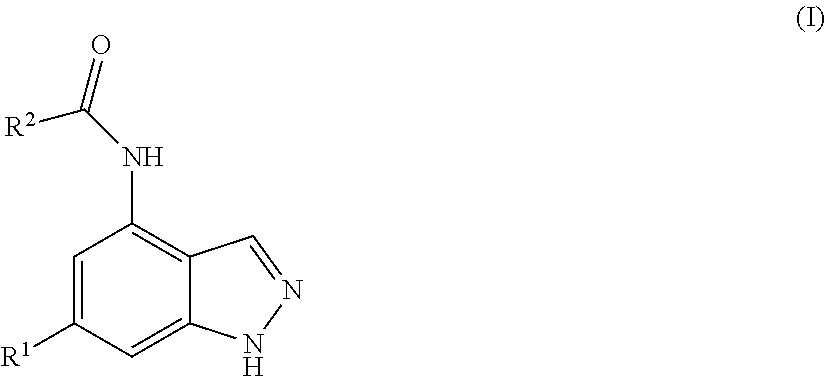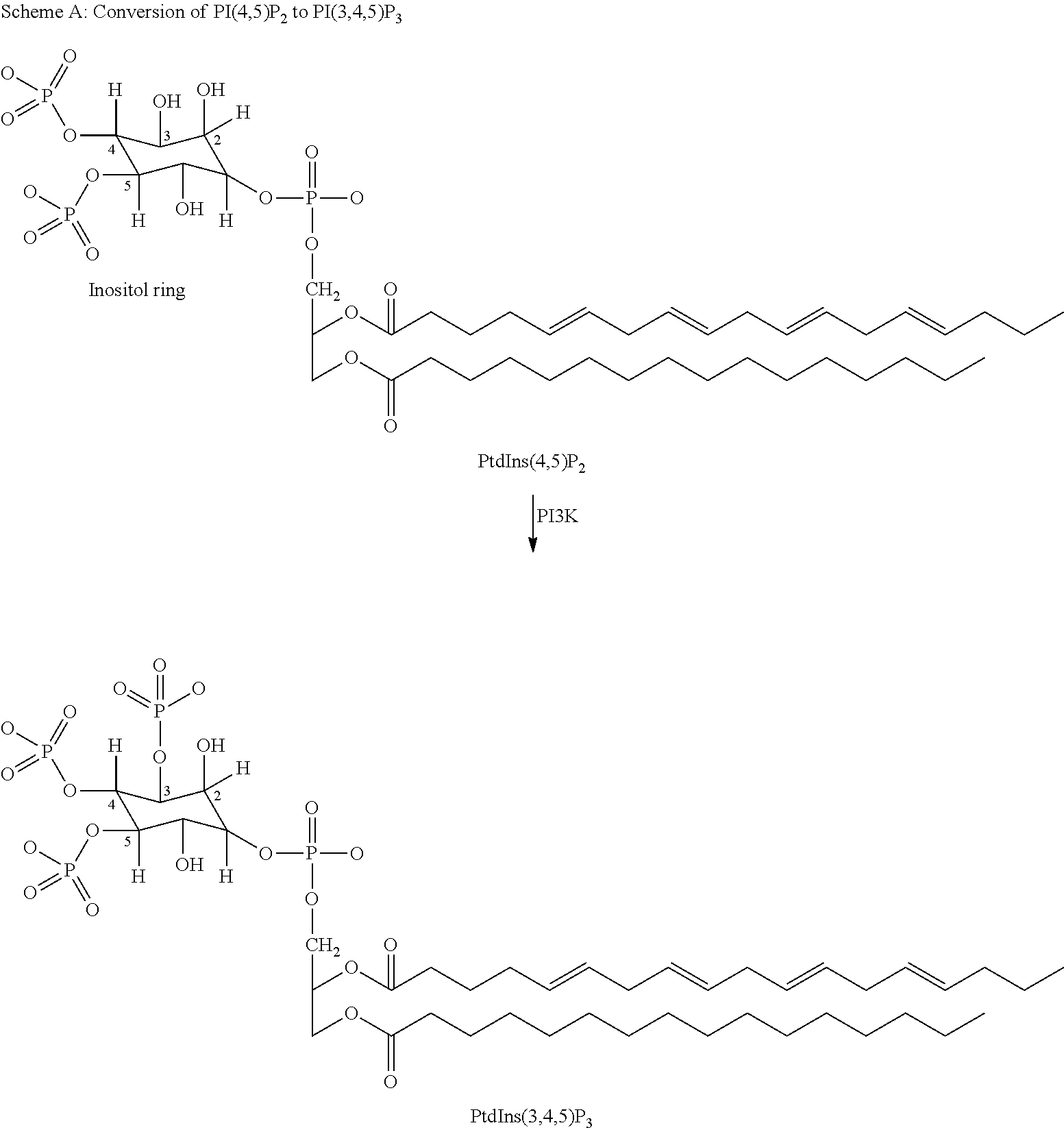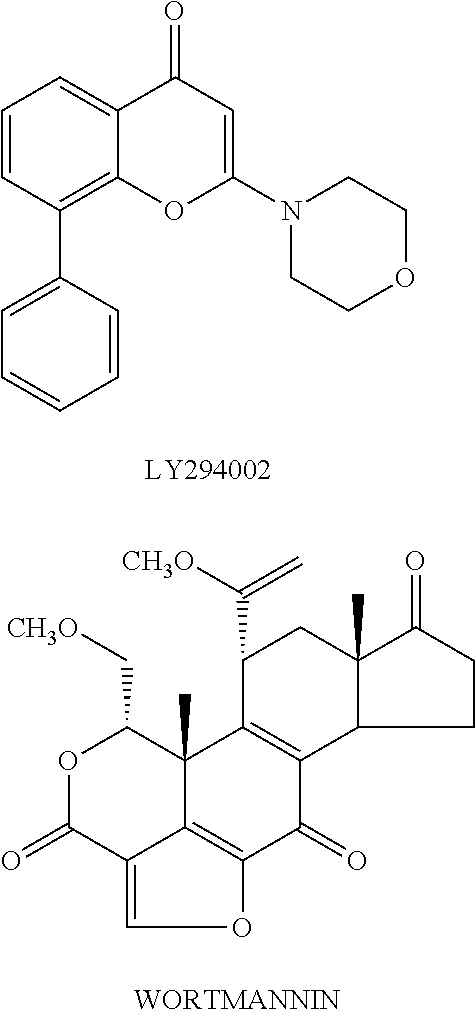Indazole derivatives as pi 3-kinase
a technology of indazole derivatives and pi 3kinase, which is applied in the field of indazole derivatives as pi 3kinase, can solve the problem of limited expression of the enzym
- Summary
- Abstract
- Description
- Claims
- Application Information
AI Technical Summary
Benefits of technology
Problems solved by technology
Method used
Image
Examples
example 1
N-{6-[5-Amino-6-(methyloxy)-3-pyridinyl]-1H-indazol-4-yl}-2-methyl-1,3-thiazole-4-carboxamide
[0427]
[0428]2-Methyl-N-[2-(tetrahydro-2H-pyran-2-yl)-6-(4,4,6,6-tetramethyl-1,3,2-dioxaborinan-2-yl)-2H-indazol-4-yl]-1,3-thiazole-4-carboxamide (50 mg), 5-bromo-2-(methyloxy)-3-pyridinamine (21 mg) and Pd(dppf)Cl2 (8 mg) were combined in a microwave vial. 1,4-Dioxane (0.5 ml) was added followed by sodium carbonate (44 mg) dissolved in water (0.5 ml). The reaction was heated in the microwave at 140° C. for 20 min. The reaction was filtered through a silica cartridge (1 g) washing with DCM:methanol (3:1). The solvent was then removed under a stream of nitrogen. The residue was dissolved in DMSO (1.2 ml) and methanol (0.4 ml) and purified using MDAP (method D). The product-containing fractions were left overnight to deprotect. The residue was dissolved in 1,4-dioxane:water (2 ml, 1:1, v / v) and freeze-dried. The residue was dissolved in DCM, a few drops of TFA were added and the reaction left o...
example 5
N-[6-(5-Amino-3-pyridinyl)-1H-indazol-4-yl]-2-methyl-1,3-thiazole-4-carboxamide
[0431]
[0432]2-Methyl-N-[1-(phenylsulfonyl)-6-(trimethylstannanyl)-1H-indazol-4-yl]-1,3-thiazole-4-carboxamide (1 g) was dissolved in DMF (4 ml) and 400 μl was dispensed to 5-bromo-3-pyridinamine (0.18 mmol) in DMF (400 μl) in a microwave vessel. Solvias catalyst (4 mg) was added and the reaction was heated in the Anton Parr microwave using initial 700 W to 135° C. for 20 min. The solution was loaded onto C18 SPE (pre-conditioned with 0.1% TFA in MeCN) and flushed through with 0.1% TFA in MeCN (3 ml). The solvent was removed under nitrogen blowdown. The sample was dissolved in DMSO (0.5 ml) and purified by MDAP (method C). The solvent was evaporated in vacuo using the Genevac. The sample was dissolved in IPA (300 μl) and 2M NaOH (aq) (300 μl) was added. The reaction was left overnight. The sample was dissolved in DMSO (0.6 ml) and purified by MDAP (method C). The solvent was evaporated in vacuo using the G...
example 8
{[3-(4-{[(2-Methyl-1,3-thiazol-4-yl)carbonyl]amino}-1H-indazol-6-yl)phenyl]oxy}acetic acid
[0435]
[0436]2-Methyl-N-[2-(tetrahydro-2H-pyran-2-yl)-6-(4,4,6,6-tetramethyl-1,3,2-dioxaborinan-2-yl)-2H-indazol-4-yl]-1,3-thiazole-4-carboxamide (50 mg), [(3-bromophenyl)oxy]acetic acid (7.6 mg) and sodium carbonate (44 mg) were added to a microwave vial. Pd(dppf)Cl2 (24 mg) was added followed by 1,4-dioxane (0.5 ml) and water (0.5 ml). The reaction was heated at 140° C. for 20 min in the microwave. The material was passed though a 1 g silica cartridge with DCM:methanol. The residue was dissolved in DMSO:methanol (1.6 ml, 1:1, v / v), passed through a C18 cartridge (1 g) washing with MeCN and evaporated under nitrogen blow down. The residue was dissolved in DMSO:methanol (1.6 ml, 1:1, v / v) and purified by MDAP (method D). Pure fractions were combined, blown down under nitrogen, suspended in 1,4-dioxane:water (ca. 3 ml, 1:1, v / v) and freeze-dried. Further purification by MDAP (method A) gave the t...
PUM
| Property | Measurement | Unit |
|---|---|---|
| Temperature | aaaaa | aaaaa |
| Volume | aaaaa | aaaaa |
| Volume | aaaaa | aaaaa |
Abstract
Description
Claims
Application Information
 Login to View More
Login to View More - R&D
- Intellectual Property
- Life Sciences
- Materials
- Tech Scout
- Unparalleled Data Quality
- Higher Quality Content
- 60% Fewer Hallucinations
Browse by: Latest US Patents, China's latest patents, Technical Efficacy Thesaurus, Application Domain, Technology Topic, Popular Technical Reports.
© 2025 PatSnap. All rights reserved.Legal|Privacy policy|Modern Slavery Act Transparency Statement|Sitemap|About US| Contact US: help@patsnap.com



